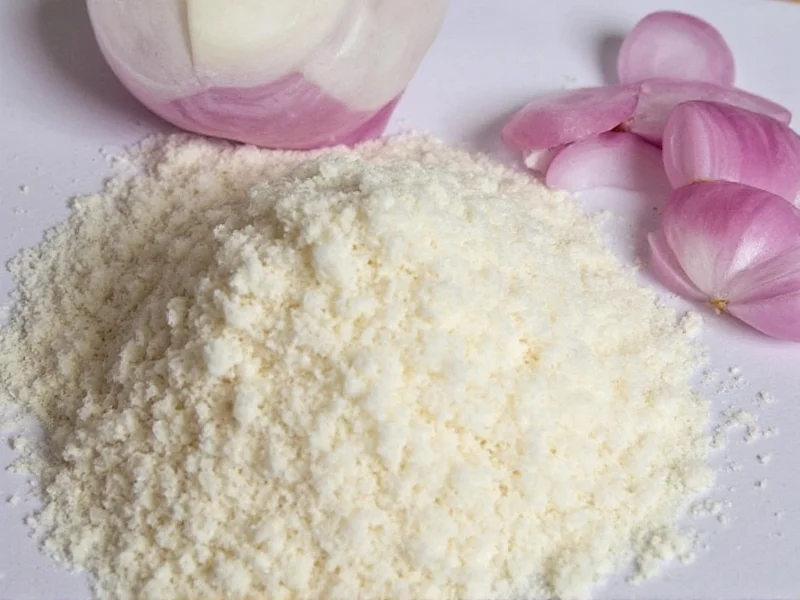Understanding Onion Powder as a Fresh Onion Substitute
When you need to sub onion powder for onion in recipes, understanding the fundamental differences between these forms is essential. Onion powder provides concentrated flavor without moisture, making it ideal for dry rubs, spice blends, and cooked dishes where texture isn't critical. The dehydration process intensifies certain compounds while diminishing others, creating a more pungent but less complex flavor profile than fresh onions.
Precision Conversion Guide for Cooking
Accurate measurement ensures your dishes maintain proper flavor balance. The standard conversion works because dehydration concentrates flavor compounds approximately sixfold. However, recipe type significantly impacts substitution success.
| Fresh Onion Measurement | Onion Powder Equivalent | Liquid Adjustment | Best For |
|---|---|---|---|
| 1 medium onion (½ cup chopped) | 1 tablespoon | Add 2-3 tbsp liquid | Stews, soups, sauces |
| 1 small onion (⅓ cup chopped) | 2½ teaspoons | Add 1½-2 tbsp liquid | Dry rubs, spice blends |
| 1 large onion (1 cup chopped) | 2 tablespoons | Add ¼ cup liquid | Baked goods, casseroles |
| ¼ cup minced onion | 1½ teaspoons | Add 1 tbsp liquid | Quick breads, dressings |
When Onion Powder Works Best as a Substitute
Certain cooking applications respond exceptionally well to substituting onion powder for fresh onion. Slow-cooked dishes like chili, beef stew, and tomato sauce benefit from powder's concentrated flavor that melds seamlessly during long cooking times. Dry applications including spice rubs, seasoning blends, and baked goods achieve more consistent flavor distribution with powder.
Consider these ideal substitution scenarios:
- Tomato-based sauces - Powder integrates without altering texture
- Dry spice rubs - Provides uniform flavor without moisture
- Casseroles - Distributes flavor evenly throughout
- Meatloaf and burgers - Prevents excess moisture
- Quick breads - Maintains proper crumb structure
Critical Adjustments for Successful Substitution
Simply swapping measurements won't yield optimal results when you sub onion powder for onion. The absence of moisture requires strategic liquid adjustments. For every tablespoon of powder used, add 2-3 tablespoons of water, broth, or other recipe-appropriate liquid to compensate for the missing moisture.
Timing matters significantly. Add onion powder early in the cooking process for maximum flavor integration, unlike fresh onions which often benefit from sautéing first. In raw applications like salads or salsas, avoid substitution entirely as powder creates unpleasant texture and overwhelming flavor.
Common Substitution Mistakes to Avoid
Many home cooks make critical errors when attempting to substitute onion powder for fresh onion. The most frequent mistake is using equal volume measurements without accounting for concentration differences. Another common issue involves failing to adjust liquid content, resulting in dry or overly salty dishes.
Be mindful of these pitfalls:
- Using powder in raw applications where texture matters
- Not adjusting salt levels (powder often contains anti-caking agents)
- Adding powder too late in cooking process
- Substituting in delicate dishes like French onion soup
- Ignoring recipe-specific moisture requirements
Advanced Substitution Techniques
For exceptional results when you need to sub onion powder for onion, consider these professional techniques. Reconstitute powder with equal parts warm water 15 minutes before use to mimic fresh onion moisture content. Combine with a pinch of sugar to balance the intensified sulfur compounds. In dishes requiring onion's natural sweetness, add ¼ teaspoon sugar per tablespoon of powder.
When substituting in recipes calling for caramelized onions, use 1½ tablespoons powder plus ½ teaspoon brown sugar per medium onion equivalent. The sugar compensates for lost Maillard reaction complexity while the extra powder accounts for flavor evaporation during caramelization.











 浙公网安备
33010002000092号
浙公网安备
33010002000092号 浙B2-20120091-4
浙B2-20120091-4